
Kerameikos also known by its Latinized form Ceramicus, is an area of Athens, Greece, located to the northwest of the Acropolis, which includes an extensive area both within and outside the ancient city walls, on both sides of the Dipylon Gate and by the banks of the Eridanos River. It was the potters' quarter of the city, from which the English word "ceramic" is derived, and was also the site of an important cemetery and numerous funerary sculptures erected along the Sacred Way, a road from Athens to Eleusis.
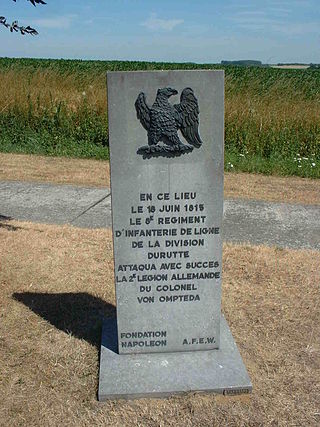
A stele, or occasionally stela when derived from Latin, is a stone or wooden slab, generally taller than it is wide, erected in the ancient world as a monument. The surface of the stele often has text, ornamentation, or both. These may be inscribed, carved in relief, or painted.

Rhamnous, also Ramnous or Rhamnus, was an ancient Greek city in Attica situated on the coast, overlooking the Euboean Strait. Its ruins lie northwest of the modern town of Agia Marina in the municipality of Marathon.

The naiskos is a small temple in classical order with columns or pillars and pediment.
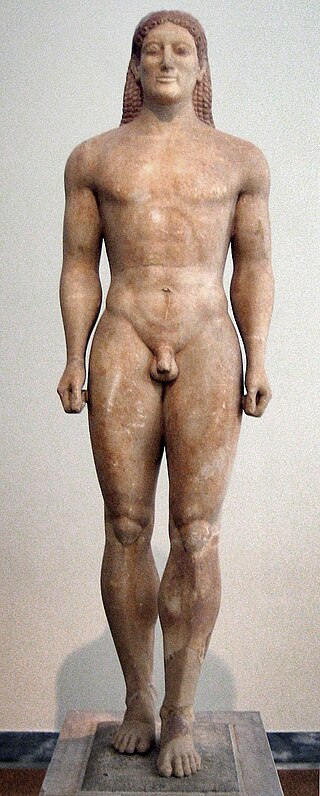
The Kroisos Kouros is a marble kouros from Anavyssos (Ανάβυσσος) in Attica which functioned as a grave marker for a fallen young warrior named Kroisos (Κροῖσος).
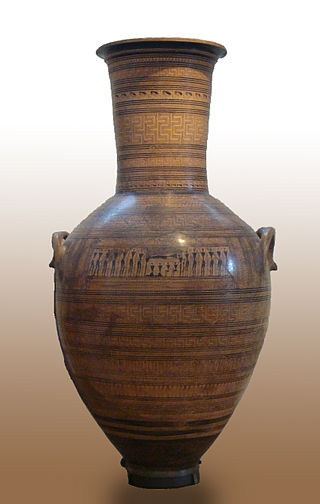
Geometric art is a phase of Greek art, characterized largely by geometric motifs in vase painting, that flourished towards the end of the Greek Dark Ages and a little later, c. 1050–700 BC. Its center was in Athens, and from there the style spread among the trading cities of the Aegean. The so-called Greek Dark Ages were considered to last from c. 1100 to 800 BC and include the phases from the Protogeometric period to the Middle Geometric I period, which Knodell (2021) calls Prehistoric Iron Age. The vases had various uses or purposes within Greek society, including, but not limited to, funerary vases and symposium vases.
Kore is the modern term given to a type of free-standing ancient Greek sculpture of the Archaic period depicting female figures, always of a young age. Kouroi are the youthful male equivalent of kore statues.
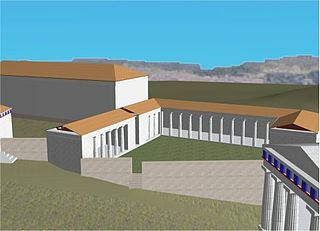
The Brauroneion was the sanctuary of Artemis Brauronia on the Athenian Acropolis, located in the southwest corner of the Acropolis plateau, between the Chalkotheke and the Propylaea in Greece. It was originally dedicated during the reign of Peisistratos. Artemis Brauronia, protector of women in pregnancy and childbirth, had her main sanctuary at Brauron, a demos on the east coast of Attica.

The Dipylon was the main gate in the city wall of Classical Athens. Located in the modern suburb of Kerameikos, it led to the namesake ancient cemetery, and to the roads connecting Athens with the rest of Greece. The gate was of major ceremonial significance as the starting point of the procession of the Great Panathenaea, and accordingly it was a large, monumental structure, "the largest gate of the ancient world". Erected in 478 BC as part of Themistocles' fortification of Athens and rebuilt in the 300s BC, it remained standing and in use until the 3rd century AD.

The Grave Stele of Hegeso, most likely sculpted by Callimachus, is renowned as one of the finest Attic grave stelae surviving today. Dated from c. 410 – c. 400 BCE, it is made entirely of Pentelic marble. It stands 1.49m high and 0.92m wide, in the form of a naiskos, with pilasters and a pediment featuring palmette acroteria. The relief, currently on display at the National Archaeological Museum in Athens was found in 1870 in the Kerameikos in Athens, which now houses a replica of it.

The Kerameikos Archaeological Museum is located in Kerameikos, Athens, Greece and was built in 1937. It houses many important early Geometric art pieces that date as far back as 860 BC. It was expanded in the 1960s by the Boehringer brothers of Boehringer Ingelheim fame. Its official address is Ermou, Athens 125, Greece.

The Funerary naiskos of Aristonautes is a funerary monument dating to around 320 BC, on display in the National Archaeological Museum of Athens (NAMA) with the inventory number 738.

Erechtheis was a phyle (tribe) of ancient Athens with fourteen demes, named for the legendary king Erechtheus.

Palmyrene funerary reliefs are almost 4,000 busts on decorative slabs closing burial niches inside underground tombs, produced in Palmyra over three centuries from the middle of the first century BC. It is the largest corpus of portrait sculpture in the Roman world outside Rome and the largest collection of funerary representations from one place in the classical world.
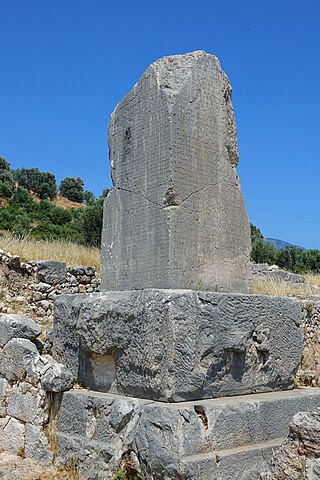
The theme of death within ancient Greek art has continued from the Early Bronze Age all the way through to the Hellenistic period. The Greeks used architecture, pottery, and funerary objects as different mediums through which to portray death. These depictions include mythical deaths, deaths of historical figures, and commemorations of those who died in war. This page includes various examples of the different types of mediums in which death is presented in Greek art.
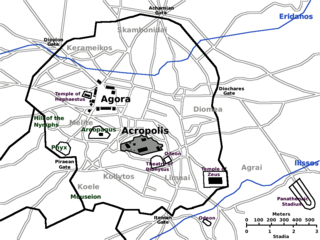
The Themistoclean Wall, named after the Athenian statesman Themistocles, was built in Athens, Greece during the 5th century BC as a result of the Persian Wars and in the hopes of defending against further invasion.

The Grave Stele of Dexileos is the stele of the tomb of an Athenian cavalryman named Dexileos who died in the Corinthian War against Sparta in 394 BC. The stele is attributed to "The Dexileos Sculptor". Its creation can be dated to 394 BC, based on the inscription on its bottom, which provides the dates of birth and death of Dexileos. The stele is made out of an expensive variety of Pentelic marble and is 1.86 metres tall. It includes a high relief sculpture depicting a battle scene with an inscription below it. The stele was discovered in 1863 in the family plot of Dexileos at the Dipylon cemetery in the Kerameikos cemetery of Athens. It was found in situ, but moved during World War II, and is now on display in the Kerameikos Museum in Athens.
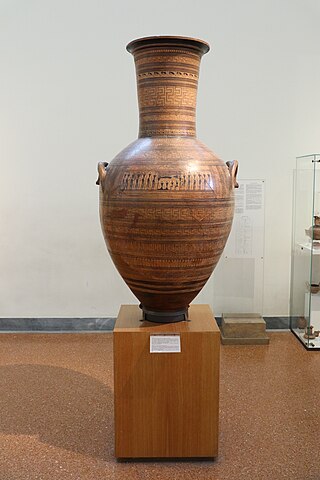
The Dipylon Amphora is a large Ancient Greek painted vase, made around 760–750 BC, and is now held by the National Archaeological Museum, Athens. Discovered at the Dipylon cemetery, this stylistic vessel belonging to the Geometric period is credited to an unknown artist: the Dipylon Master. The amphora is covered entirely in ornamental and geometric patterns, as well as human figures and animal-filled motifs. It is also structurally precise, being that it is as tall as it is wide. These decorations use up every inch of space, and are painted on using the black-figure technique to create the silhouetted shapes. Inspiration for the Greek vase derived not only from its intended purpose as a funerary vessel, but also from artistic remnants of Mycenaean civilization prior to its collapse around 1100 BC. The Dipylon Amphora signifies the passing of an aristocratic woman, who is illustrated along with the procession of her funeral consisting of mourning family and friends situated along the belly of the vase. The woman's nobility and status is further emphasized by the plethora of detail and characterized animals, all which remain in bands circling the neck and belly of the amphora.
There are two tumuli at Marathon, Greece. One is a burial mound, or "Soros" that houses the ashes of 192 Athenians who fell during the Battle of Marathon in 490 BC. The other houses the inhumed bodies of the Plataeans who fell during that same battle. The burial mound dominates the plain of Marathon, where the eponymous battle took place, along with the tumulus of the Plataeans, and a victory column erected by the Athenians to commemorate their victory over Darius' Persian expedition. The tumulus is encompassed in a park today.

The Funerary naiskos of Demetria and Pamphile is a tomb memorial in honour of two deceased women named Demetria and Pamphile, erected in Athens in around 320 BC, shortly after Pamphile's death. It is made of marble and now kept at the Kerameikos Archaeological Museum in Athens, Greece, with inventory number P687, while a copy of it is found on the ancient site of the tomb.



















